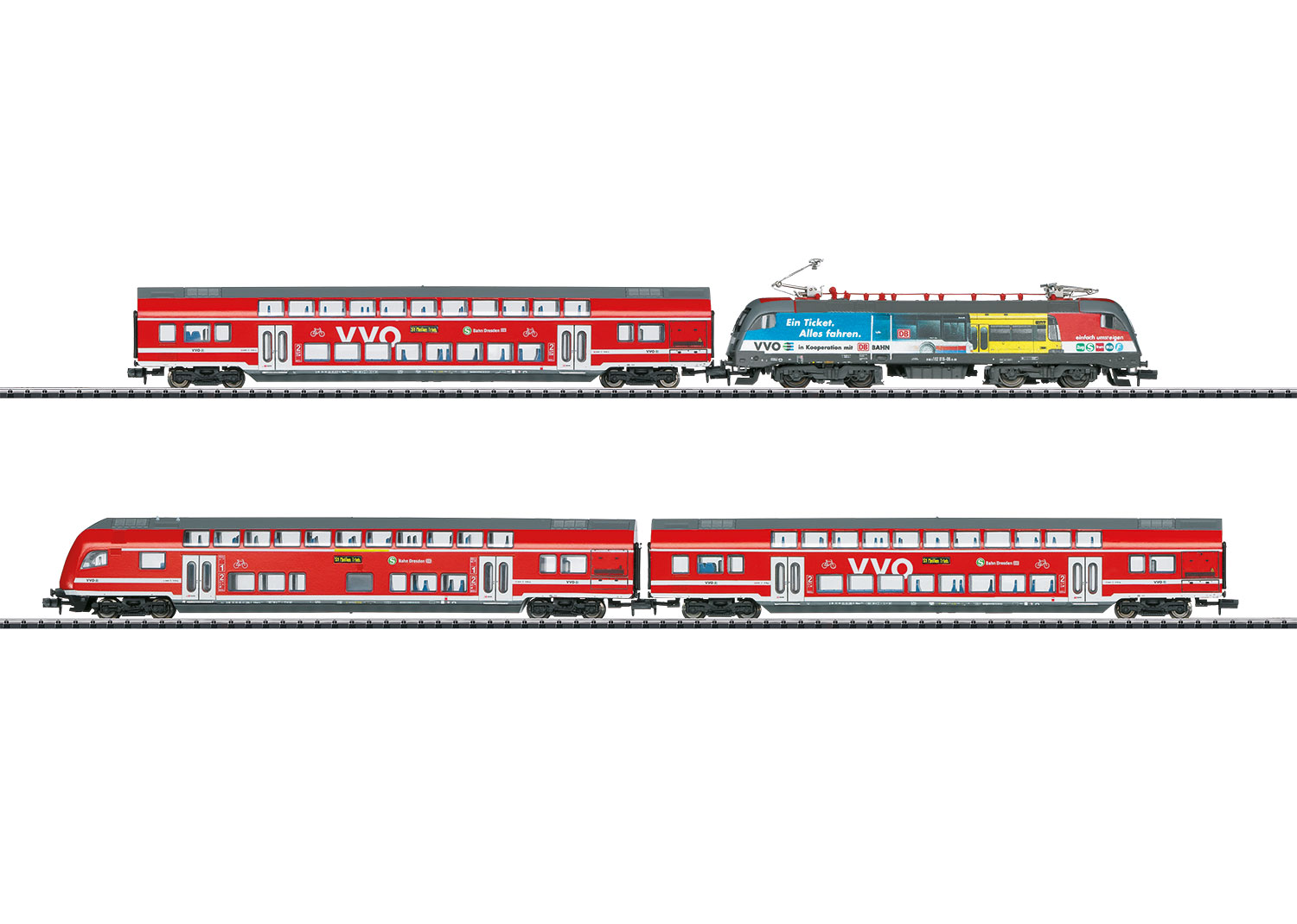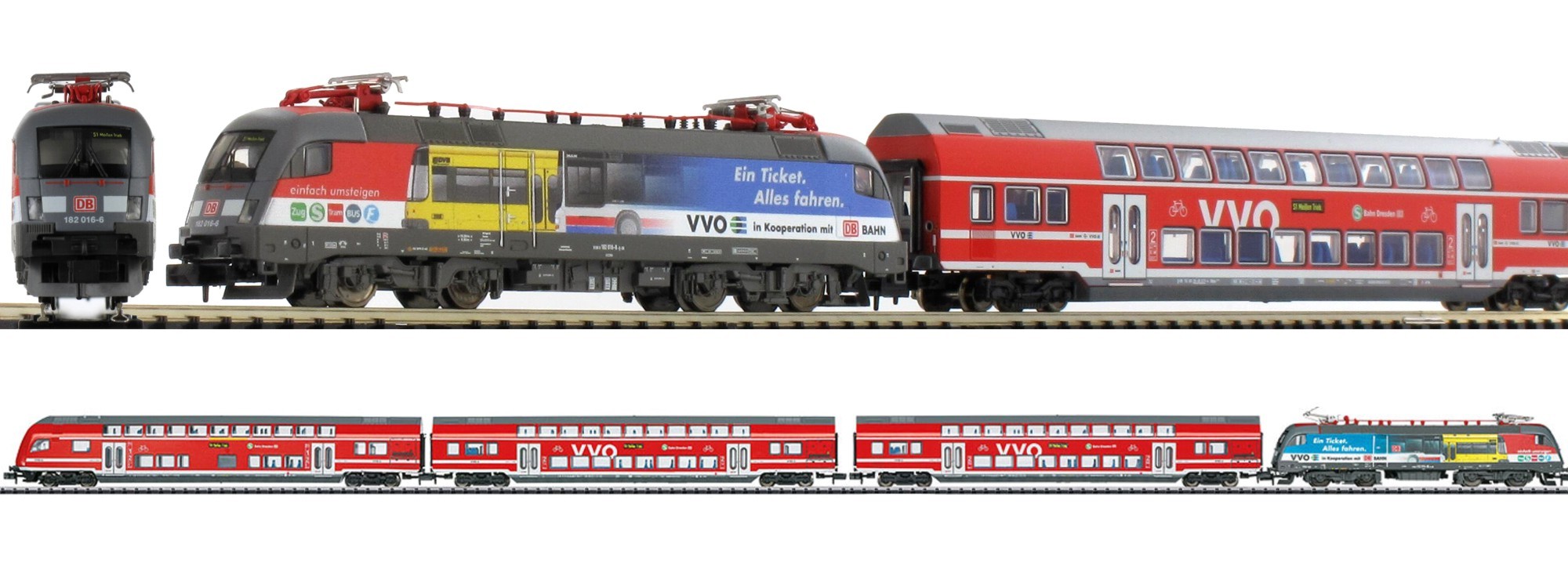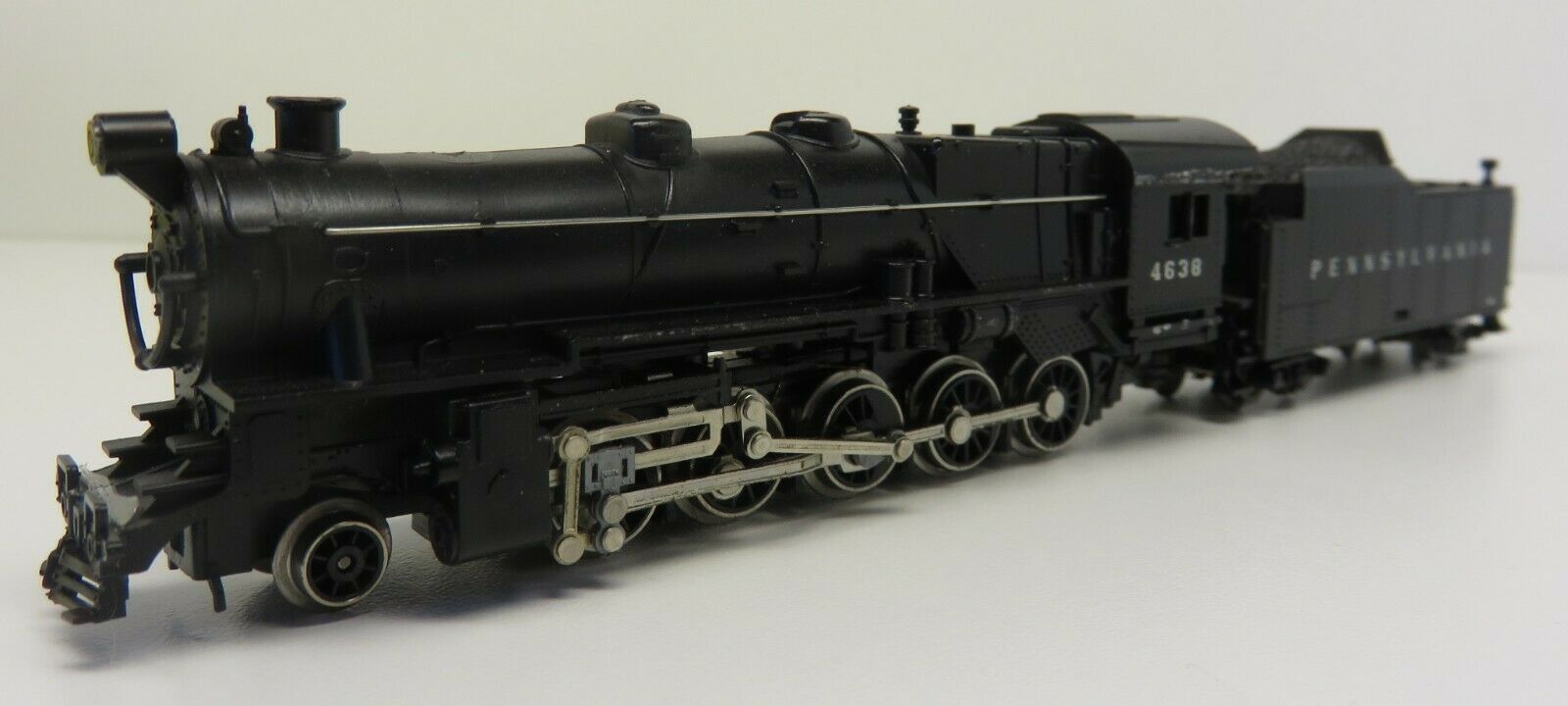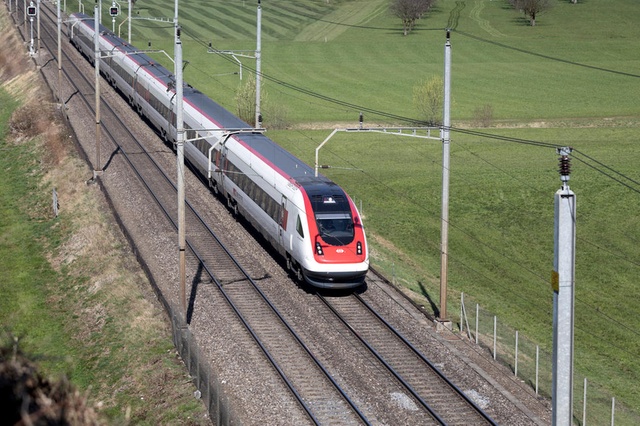Specific Item Information:
Prototype: Electric locomotive road number 182 016-6, 2 bi-level cars, 2nd class, and 1 bi-level cab control car, 1st/2nd class, used on the German Railroad, Inc. (DB AG), painted and lettered for the Dresden S-Bahn in the Upper Elbe, Inc. (VVO) Transport Association.
Model: The locomotive has a 14-pin digital interface connector. It has a motor with a flywheel, 4 axles powered, traction tires, and LED headlights. The bi-level cars have built-in LED interior lighting, including lighted train destination displays, and close coupler mechanisms. The bi-level cab control car has white/red headlight / marker light changeover that works in digital and analog operation. Total length over the buffers 623 mm / 24-1/2".
Highlights LED headlights. LED interior lighting. Lighted train destination displays.
Model: The locomotive has a 14-pin digital interface connector. It has a motor with a flywheel, 4 axles powered, traction tires, and LED headlights. The bi-level cars have built-in LED interior lighting, including lighted train destination displays, and close coupler mechanisms. The bi-level cab control car has white/red headlight / marker light changeover that works in digital and analog operation. Total length over the buffers 623 mm / 24-1/2".
Highlights LED headlights. LED interior lighting. Lighted train destination displays.
Prototype History: Many modern European trains run using overhead/catenary wire. Rail networks in Western and Central Europe are often well maintained and well developed, whilst Eastern, Northern and Southern Europe often have less coverage and/or infrastructure problems. Electrified railway networks operate at a plethora of different voltages AC and DC varying from 750 to 25,000 volts, and signalling systems vary from country to country, hindering cross-border traffic.
The European Union aims to make cross-border operations easier as well as to introduce competition to national rail networks. EU member states were able to separate the provision of transport services and the management of the infrastructure by the Single European Railway Directive 2012. Usually, national railway companies were split to separate divisions or independent companies for infrastructure, passenger and freight operations. The passenger operations may be further divided to long-distance and regional services, because regional services often operate under public service obligations (which subsidise unprofitable but socially desirable routes), while long-distance services usually operate without subsidies.
The European Union aims to make cross-border operations easier as well as to introduce competition to national rail networks. EU member states were able to separate the provision of transport services and the management of the infrastructure by the Single European Railway Directive 2012. Usually, national railway companies were split to separate divisions or independent companies for infrastructure, passenger and freight operations. The passenger operations may be further divided to long-distance and regional services, because regional services often operate under public service obligations (which subsidise unprofitable but socially desirable routes), while long-distance services usually operate without subsidies.
Road Name History: The Dresden S-Bahn is a network of S-Bahn-type commuter train services in Dresden and the surrounding area. It is commissioned by Verkehrsverbund Oberelbe (VVO) from DB Regio Verkehrsbetrieb Südostsachsen and currently consists of three services operating over a 127.7 km-long network.
The S-Bahn fare structure was introduced on a series of suburban railway lines on 29 September 1974. The term "S-Bahn" has only officially been used for the system since 31 May 1992. Since 24 May 1998, VVO fares have been valid for the S-Bahn Dresden. Outside of Dresden, it runs to the centres of Freital, Meissen, Pirna, Radebeul and since 9 December 2007 also to Freiberg. All lines stop at Dresden Hauptbahnhof.
According to data from the Deutsche Bahn, the Dresden S-Bahn is the S-Bahn with the highest customer satisfaction in Germany.
The S-Bahn fare structure was introduced on a series of suburban railway lines on 29 September 1974. The term "S-Bahn" has only officially been used for the system since 31 May 1992. Since 24 May 1998, VVO fares have been valid for the S-Bahn Dresden. Outside of Dresden, it runs to the centres of Freital, Meissen, Pirna, Radebeul and since 9 December 2007 also to Freiberg. All lines stop at Dresden Hauptbahnhof.
According to data from the Deutsche Bahn, the Dresden S-Bahn is the S-Bahn with the highest customer satisfaction in Germany.
Brand/Importer Information: Trix is a German company that originally made Trix metal construction sets. one of its co-founders was Stephan Bing, the son of the pioneer toy-maker industrialist Ignaz Bing. In 1935 the company began producing the electrically powered model trains that it became famous for, under the Trix Express label. Prior to the outbreak of World War II the Trix company produced a small range of fairly unrealistic AC powered three rail models running at 14 volts.
N gauge models under the Minitrix brand were made from the late 1960s mostly of European prototypes (German and British primarily). North American prototypes were also manufactured and marketed under the Aurora "Postage Stamp" brand; later these items were sold under the American Tortoise, Model Power and Con-Cor brands. Trix sometimes utilized North American consultants to aid in the design of this portion of the product line. The "Hornby Minitrix' brand was used in the 1980s for a short lived range of British outline models using the earlier product tooling.
Trix's owner in the 1980s and 1990s was Mangold, which went bankrupt in the late 1990s and Märklin purchased the assets in January 1997. In part, this purchase was a reflection of Märklin's need for added production capacity; Trix had been manufacturing certain items for Märklin in previous years. The purchase was also in response to the earlier purchase of the Karl Arnold company by the Italian company Rivarossi; Märklin were very keen to take over Trix market share in 2-rail H0 and especially Minitrix, until then Märklin had not marketed N gauge models. In 2003, Märklin introduced its first N gauge models under the well established Minitrix brand. A number Märklin H0 scale three-rail AC locomotives have also been introduced in two-rail DC versions under the Trix logo and many models are shared between the two brands.
From Wikipedia
N gauge models under the Minitrix brand were made from the late 1960s mostly of European prototypes (German and British primarily). North American prototypes were also manufactured and marketed under the Aurora "Postage Stamp" brand; later these items were sold under the American Tortoise, Model Power and Con-Cor brands. Trix sometimes utilized North American consultants to aid in the design of this portion of the product line. The "Hornby Minitrix' brand was used in the 1980s for a short lived range of British outline models using the earlier product tooling.
Trix's owner in the 1980s and 1990s was Mangold, which went bankrupt in the late 1990s and Märklin purchased the assets in January 1997. In part, this purchase was a reflection of Märklin's need for added production capacity; Trix had been manufacturing certain items for Märklin in previous years. The purchase was also in response to the earlier purchase of the Karl Arnold company by the Italian company Rivarossi; Märklin were very keen to take over Trix market share in 2-rail H0 and especially Minitrix, until then Märklin had not marketed N gauge models. In 2003, Märklin introduced its first N gauge models under the well established Minitrix brand. A number Märklin H0 scale three-rail AC locomotives have also been introduced in two-rail DC versions under the Trix logo and many models are shared between the two brands.
From Wikipedia
Item created by: gdm on 2019-05-24 09:49:44. Last edited by CNW400 on 2020-07-10 11:00:18
If you see errors or missing data in this entry, please feel free to log in and edit it. Anyone with a Gmail account can log in instantly.
If you see errors or missing data in this entry, please feel free to log in and edit it. Anyone with a Gmail account can log in instantly.












